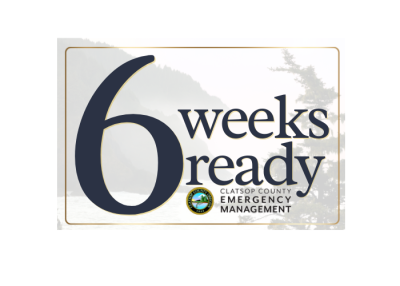
Week 6 of Clatsop County’s 6-Weeks Ready Emergency Preparedness campaign focuses on the earthquake safety.
“The Great Shakeout is only days away, so this week, we are focusing on ways to protect yourself before and during an earthquake,” said Emergency Management Director Justin Gibbs.
Secure Your Home or Office
- Secure heavy items in your home like bookcases, refrigerators, water heaters, televisions and objects that hang on walls. Store heavy and breakable objects on low shelves.
- Consider making improvements to your home to fix structural issues that could cause your home to collapse during an earthquake.
- Consider getting an earthquake insurance policy. A standard homeowner’s insurance policy does not cover earthquake damage.
Drop, Cover and Hold On
1. DROP
As soon as you notice the first signs of an earthquake, drop onto your hands and knees. Earthquakes are very powerful and might knock you down if you remain standing, which could cause injury.
When you drop to the floor and stay low, you will be in a more stable, safe position. From a dropped position on your knees, you can also crawl to cover more easily. If you are seated and cannot drop to the floor, follow steps 2 and 3: Cover and Hold On.
2. COVER
Even small items in your home, such as a vase on a bookshelf or a framed photo on the wall, could cause severe injury if they fall onto you during an earthquake.
During an earthquake, remain dropped on your knees and bend over to protect your head and vital organs. If there is a sturdy desk or table nearby, crawl underneath it for cover. Otherwise, crawl next to an inside wall and get as far away from windows as possible.
3. HOLD ON
Furniture might shift around during the earthquake, so if the table or desk you are under moves, you need to move with it to avoid being injured by it. That means holding on with one or both hands during the shaking. If you are not sheltered under furniture, use both arms and hands to hold on to your head and neck.
Stay in your covered, dropped position until shaking stops.
After the initial jolt, there is still a chance of aftershocks, building damage, and other dangers, so it is important to remain aware of additional dangers after the initial earthquake.
After the Earthquake
As soon as the ground stops shaking, assess your location, especially whether you are in a landslide or tsunami inundation zone. If needed, move to higher ground or a safer location.
Check your immediate area for injured people and for any new hazards that may have formed, such as leaking gas lines, building damage or collapse, or broken water or electric lines.
What to do in Other Situations
We don’t know when an earthquake will strike. It could happen when you are home, at work, away or in a car. Here’s what to do in different situations:
- IN BED: Stay in bed and lie down. Hold on to your head and neck with both hands. You can cover your head and neck with a pillow for additional protection.
- OUTDOORS: If you can safely do so, head to an open, clear area free of hazards like trees, street signs, buildings, and vehicles. Be mindful that objects might still fall from the side, so follow the drop, cover, and hold on rules to protect yourself.
- DRIVING: Stay inside your vehicle. When it is safe to do so, pull over to the side of the road, come to a complete stop, and activate the parking brake. Try to avoid overpasses, bridges, power lines, and other potential dangers. When you resume driving, avoid damaged areas of the highway or road, and stay clear of emergency service vehicles.
- IN A STORE: Follow the same general drop, cover, and hold on principles as you would in your home. Use what is around you for cover, such as a shopping cart or clothing racks.
- NEAR THE SHORE: If you are near a body of water or the coast, you’ll still want to follow the drop, cover, and hold on procedure. Then, when shaking slows down, quickly move inward or to higher ground in case of a tsunami. If possible, walk to avoid traffic slowdowns.
The Clatsop County 6-Weeks Ready campaign ends with the Great Shakeout. “We encourage anyone who has not yet joined us in the campaign to start now. Our website has information that can help individuals and families get prepared. We also encourage everyone to register online to participate in the Great Shakeout,” Gibbs said.
Week 1: Sept 6 Building a Kit
Week 2: Sept 13 Disaster Planning with Everyone in Mind
Week 3: Sept 20 Protecting your Family & Property in a Disaster
Sept 26 Countywide ClatsopAlerts! emergency communications test
Week 4: Sept. 27 Food & Water in an Emergency
Sept. 30 Get Ready Clatsop County Preparedness Event
Week 5: Oct 4 Tsunami Evacuation
Week 6: Oct 11 Earthquake Safety
Personal preparedness and other emergency preparedness information is on the ClatsopCounty.gov.




